外研版高中英语必修3 Module 3 The Violence of Nature 主谓一致课件 (共29张)
文档属性
| 名称 | 外研版高中英语必修3 Module 3 The Violence of Nature 主谓一致课件 (共29张) | 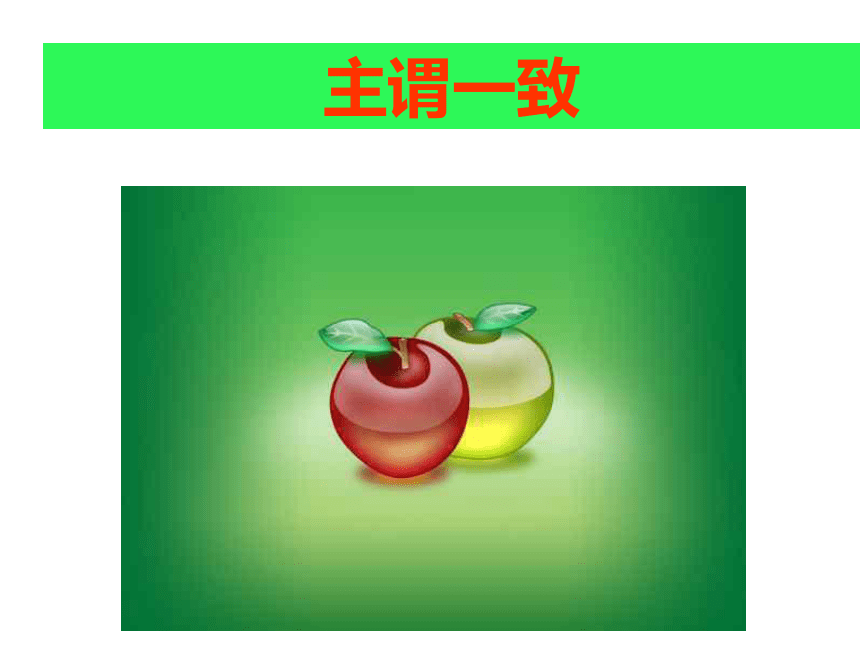 | |
| 格式 | zip | ||
| 文件大小 | 119.9KB | ||
| 资源类型 | 教案 | ||
| 版本资源 | 外研版 | ||
| 科目 | 英语 | ||
| 更新时间 | 2019-06-14 15:03:43 | ||
图片预览

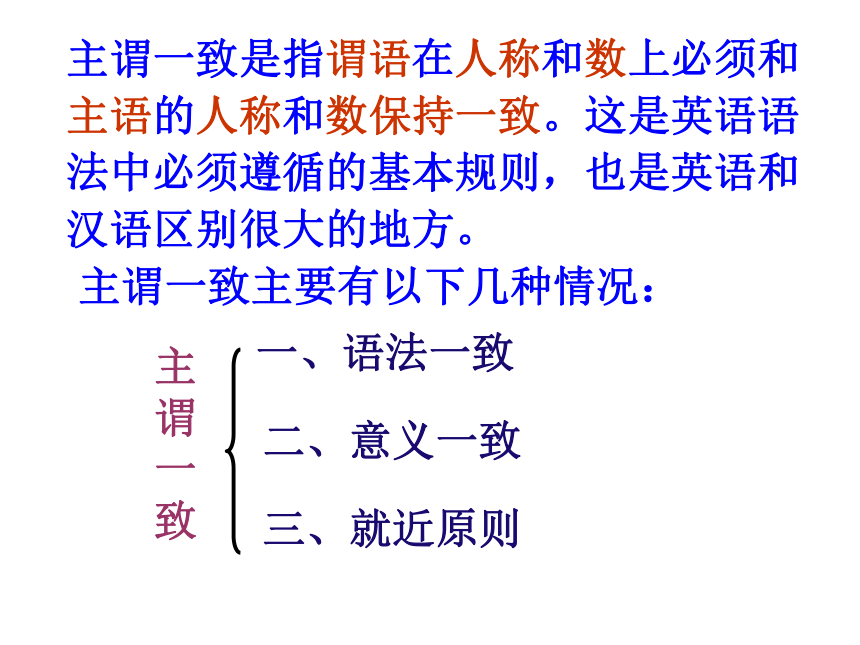

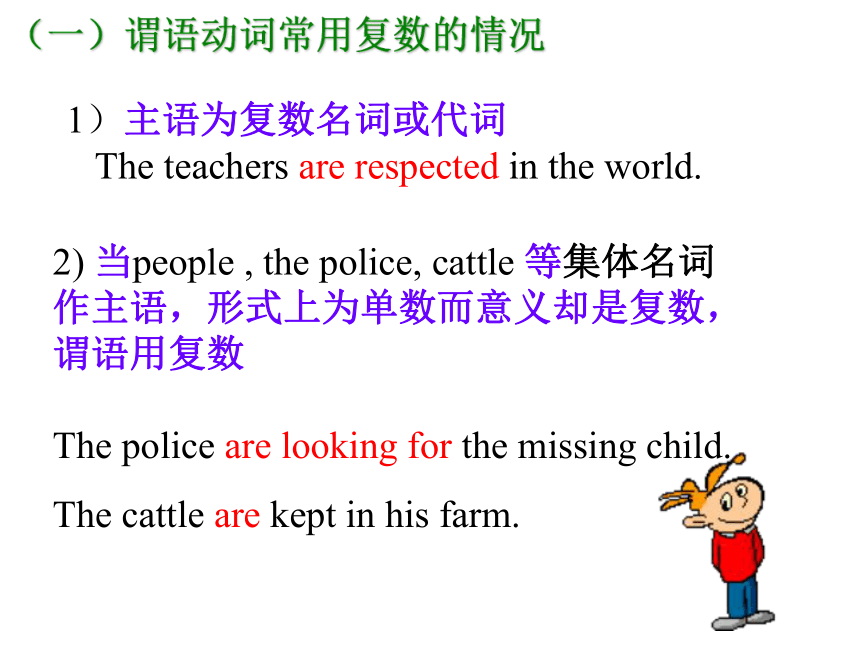

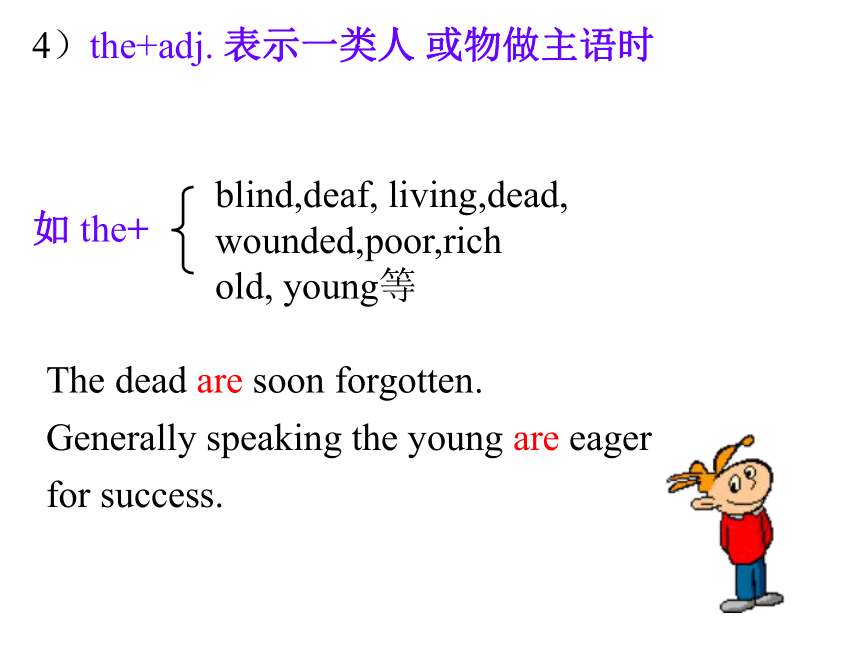

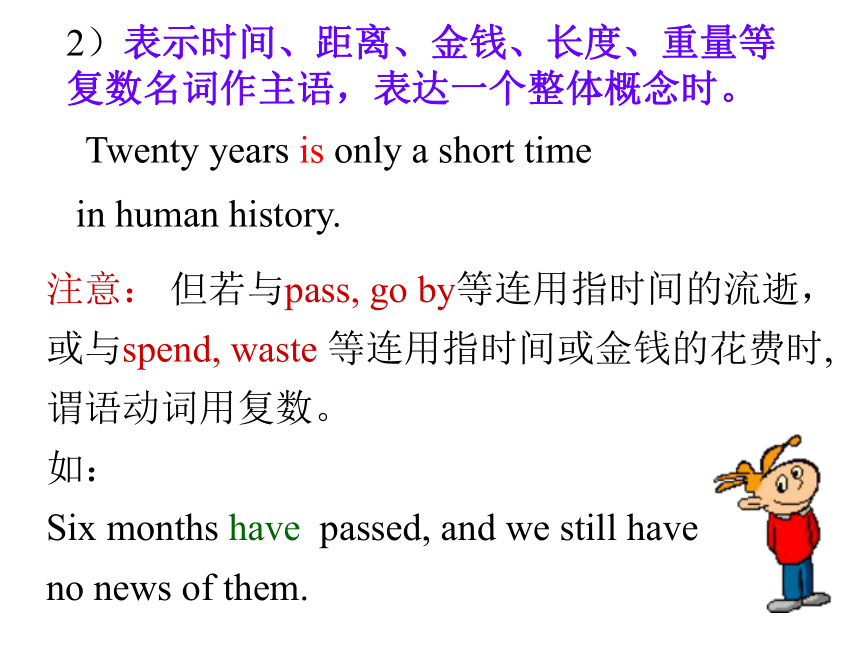
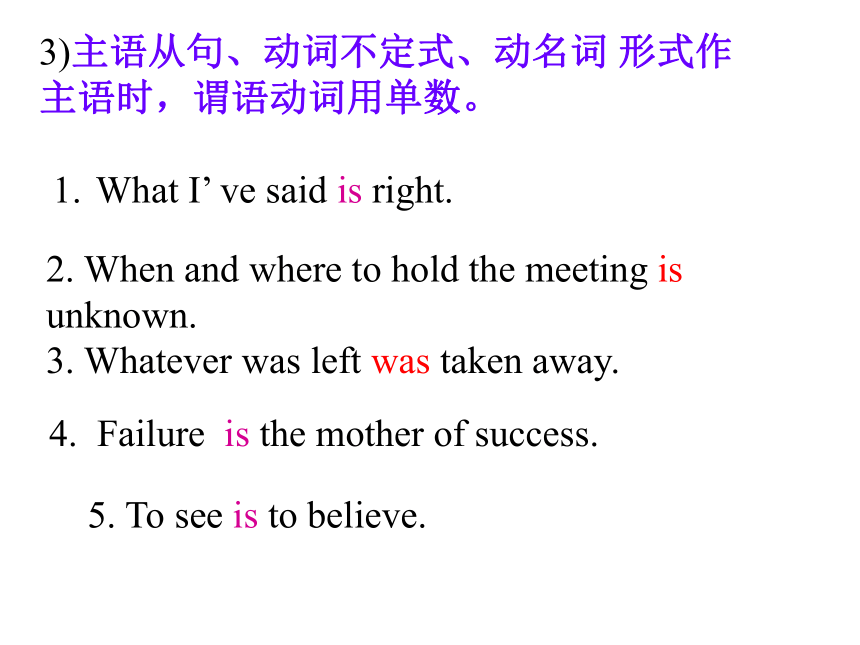
文档简介
课件29张PPT。主谓一致 主谓一致主谓一致是指谓语在人称和数上必须和主语的人称和数保持一致。这是英语语法中必须遵循的基本规则,也是英语和汉语区别很大的地方。
主谓一致主要有以下几种情况:二、意义一致三、就近原则一、语法一致 一、语法一致
主语为单数形式,谓语动词也用单数形式;
主语为复数形式,谓语动词也用复数形式。
例如:
I often help him and he often helps me.
我经常帮助他,他也经常帮助我。
We often help each other.
我们经常互相帮助。
不可数名词作主语,谓语动词用单数;
可数名词的复数形式作主语,
谓语动词用复数。(一)谓语动词常用复数的情况 1)主语为复数名词或代词
The teachers are respected in the world.2) 当people , the police, cattle 等集体名词
作主语,形式上为单数而意义却是复数,
谓语用复数
The police are looking for the missing child.
The cattle are kept in his farm.
3)山脉、群岛、瀑布、运动会等s 结尾的复数名词( the Olympic Games, clothes, goods, things, feelings, surroundings, belongings, earnings, the Ural Mountains, manners, congratulations)作主语。
The Olympic Games are held once every
four years.
The Rocky mountains stand in the west
of the north America4)the+adj. 表示一类人 或物做主语时
如 the+blind,deaf, living,dead,
wounded,poor,rich
old, young等The dead are soon forgotten.
Generally speaking the young are eager
for success.5) the+姓的复数形式表一家人
The Whites are going to make a trip to
London.
The Greens were watching TV when
a fire broke out. (二)谓语动词常用单数的情况
1)可数名词的单数及不可数名词作
主语时。2)表示时间、距离、金钱、长度、重量等
复数名词作主语,表达一个整体概念时。
Twenty years is only a short time
in human history.
注意: 但若与pass, go by等连用指时间的流逝,
或与spend, waste 等连用指时间或金钱的花费时,
谓语动词用复数。
如:
Six months have passed, and we still have
no news of them.3)主语从句、动词不定式、动名词 形式作
主语时,谓语动词用单数。 What I’ ve said is right.2. When and where to hold the meeting is unknown.
3. Whatever was left was taken away.4. Failure is the mother of success.5. To see is to believe.4) 以-S 结尾的单数名词,形式为复数而意义为
单数. 如表示学科、国家、机构、书籍、报刊等
名称作主语, (news, physics, maths,politics ,
the United States; the New Times;
书名如Great Expectations(《远大前程》);
the United Nations), 谓语用单数。
The United states is made up of 50 states.
The Times is a newspaper for the British government
Great Expectations was written by Charles Dickens in 1860.?5) each
neither
either
+of + the+复数名词或代词Each of us has a dictionary.
Either of the books on the table belongs to me.
Neither of them is fit for the job.7) many a / each / every
either / neither
more than one+单数名词Many a student has seen the film.
Neither story is true.
More than one student has seen the film.
More students than one have seen the film.
当each放在主语后作同位语时,
不决定谓语单复数
They each have a dictionary.
=Each of them has a dictionary.8). 由some, any, no, every + one/thing/body
所构成的复合代词做主语时,谓语用单数
Nobody wants to go there.
Something has been done to end the strike.
(三)其它情况1)用and或both…and…连接的两个名词作
主语时,谓语动词用复数形式。
但是如果and连接的两个名词作主语,指同一个
人或事或整体概念(两个名词共用一个冠词),
谓语动词用单数。用is/are填空
A young man and a girl to go there.
The singer and writer famous to many
young people
.
areisWar and peace (战争与和平) a constant theme in history.
Early to bed and early to rise (早睡早起)_____ a good habit.
isisiron and steel 钢铁 law and order 治安
a watch and chain 一块带链的表
A needle and thread(针线)
a coat and tie配有领带的上衣
a knife and fork bread and butter 2)单、复数同形的名词作主语时,按意义一致的原则。作单数意义时,谓语动词用单数,反之谓语动词用复数。这类名词有:sheep, fish, deer, means(方法), species(种类),works(工厂), Chinese, Japanese等。选择填空
has/have
1. Every means been tried out without much
result. 2. All means been tried out without much
result. hashave was/were
This shoe works set up in 1980.?
Those shoe works all set up in 1980.??waswere3. 集体名词class, family, army, team, club, population, enemy, party, crowd, majority, crew, audience, government, public, group, committee等作主语。强调整体用单数,指个体成员用复数。
His family is in Harbin.
His family are music lovers.
The committee was made up of 10 members.
The committee were in the hall. 4. 就近原则
下列连词连接两个主语时,及there be句型
有多个并列主语,谓语应与最靠近的主语
保持一致。
A or B
either A or B
neither A nor B
not only A but also B
there be A, B and C
not A but B动词与靠近的主语
一致 注意:在there be 句式中,主语是两个或多个并列名词(短语),be的形式与最近的一个名词(短语)保持一致。
There _______ a pen, two pencils and several books on the desk.
There______ two pencils, a pen and several books on the desk.isare由here, there等引导的倒装句中,若主语不止一个时,谓语动词与最近的主语保持一致。如:
Here comes the bus.
Here is a pen and two books for you.5. 就前原则, “A+ as well as, as much as,
no less than, along with, with, like, rather than,
together with, but, except, besides,including,
n addition to + B”等词组时,
其谓语动词的单复数与A保持一致。1)The teacher , with 6 girls and 8 boys of her
class, ______ visiting a museum when
the earthquake struck. (NMET2004 北京卷)
A. was B . were C. had been D. would be
A6. None of + n(复数)作主语, 谓语用单数或复数均可
None of + n(单数)作主语,谓语用单数None of the cars was / were damaged.
None of the food has gone bad. 7. a number of + n(复数)作主语,谓语用复数
the number of + n(复数)作主语,谓语用单数
a large quantity of +c/u +谓语单数
large quantities of +c/u +谓语复数
A large quantity of people is needed here.
Large quantities of food have rotten away. The number of the people invited ______ fifty , but a number of them ______ absent for different reasons. (NMET 1996 )
A. were, was B. was; was
C. was; were D. were; were C8. one of + 名词(复数) + 定语从句(谓语动词
用复数);
the only, the first, the last, the right等+ 名词
(复数) + 定语从句 (谓语动词用单数)
He is one of the few persons who a
good knowledge of Italian.
havewas He is the only one of the boys who given a prize.
a great deal of/ a large amount of +u+谓语单数
但large amounts of +u+ 谓语复数9. 倒装句中,必须认准哪是主语。如:1)Between the two buildings (stand)
a monument.
2)On the ship (be) over 2,200 people.
3)More than 1,500 people lost their lives.
Among those (be) the young woman.Stands were/arewas10. such, the same起指示代词作用,应根据其所指的内容 来确定单、复数。如: Such is our plan.???????
Such are my hopes.???11. all 做主语表示人时,谓动用复数;
若表物,谓动则用单数。 All is well that ends well.
All are eager to reach an agreement.half most enough part the rest the last lots some plenty 分数 百分数+of +名词作主语谓语动词要和 of 之后的名词保持一致。 13.THANK YOU!
主谓一致主要有以下几种情况:二、意义一致三、就近原则一、语法一致 一、语法一致
主语为单数形式,谓语动词也用单数形式;
主语为复数形式,谓语动词也用复数形式。
例如:
I often help him and he often helps me.
我经常帮助他,他也经常帮助我。
We often help each other.
我们经常互相帮助。
不可数名词作主语,谓语动词用单数;
可数名词的复数形式作主语,
谓语动词用复数。(一)谓语动词常用复数的情况 1)主语为复数名词或代词
The teachers are respected in the world.2) 当people , the police, cattle 等集体名词
作主语,形式上为单数而意义却是复数,
谓语用复数
The police are looking for the missing child.
The cattle are kept in his farm.
3)山脉、群岛、瀑布、运动会等s 结尾的复数名词( the Olympic Games, clothes, goods, things, feelings, surroundings, belongings, earnings, the Ural Mountains, manners, congratulations)作主语。
The Olympic Games are held once every
four years.
The Rocky mountains stand in the west
of the north America4)the+adj. 表示一类人 或物做主语时
如 the+blind,deaf, living,dead,
wounded,poor,rich
old, young等The dead are soon forgotten.
Generally speaking the young are eager
for success.5) the+姓的复数形式表一家人
The Whites are going to make a trip to
London.
The Greens were watching TV when
a fire broke out. (二)谓语动词常用单数的情况
1)可数名词的单数及不可数名词作
主语时。2)表示时间、距离、金钱、长度、重量等
复数名词作主语,表达一个整体概念时。
Twenty years is only a short time
in human history.
注意: 但若与pass, go by等连用指时间的流逝,
或与spend, waste 等连用指时间或金钱的花费时,
谓语动词用复数。
如:
Six months have passed, and we still have
no news of them.3)主语从句、动词不定式、动名词 形式作
主语时,谓语动词用单数。 What I’ ve said is right.2. When and where to hold the meeting is unknown.
3. Whatever was left was taken away.4. Failure is the mother of success.5. To see is to believe.4) 以-S 结尾的单数名词,形式为复数而意义为
单数. 如表示学科、国家、机构、书籍、报刊等
名称作主语, (news, physics, maths,politics ,
the United States; the New Times;
书名如Great Expectations(《远大前程》);
the United Nations), 谓语用单数。
The United states is made up of 50 states.
The Times is a newspaper for the British government
Great Expectations was written by Charles Dickens in 1860.?5) each
neither
either
+of + the+复数名词或代词Each of us has a dictionary.
Either of the books on the table belongs to me.
Neither of them is fit for the job.7) many a / each / every
either / neither
more than one+单数名词Many a student has seen the film.
Neither story is true.
More than one student has seen the film.
More students than one have seen the film.
当each放在主语后作同位语时,
不决定谓语单复数
They each have a dictionary.
=Each of them has a dictionary.8). 由some, any, no, every + one/thing/body
所构成的复合代词做主语时,谓语用单数
Nobody wants to go there.
Something has been done to end the strike.
(三)其它情况1)用and或both…and…连接的两个名词作
主语时,谓语动词用复数形式。
但是如果and连接的两个名词作主语,指同一个
人或事或整体概念(两个名词共用一个冠词),
谓语动词用单数。用is/are填空
A young man and a girl to go there.
The singer and writer famous to many
young people
.
areisWar and peace (战争与和平) a constant theme in history.
Early to bed and early to rise (早睡早起)_____ a good habit.
isisiron and steel 钢铁 law and order 治安
a watch and chain 一块带链的表
A needle and thread(针线)
a coat and tie配有领带的上衣
a knife and fork bread and butter 2)单、复数同形的名词作主语时,按意义一致的原则。作单数意义时,谓语动词用单数,反之谓语动词用复数。这类名词有:sheep, fish, deer, means(方法), species(种类),works(工厂), Chinese, Japanese等。选择填空
has/have
1. Every means been tried out without much
result. 2. All means been tried out without much
result. hashave was/were
This shoe works set up in 1980.?
Those shoe works all set up in 1980.??waswere3. 集体名词class, family, army, team, club, population, enemy, party, crowd, majority, crew, audience, government, public, group, committee等作主语。强调整体用单数,指个体成员用复数。
His family is in Harbin.
His family are music lovers.
The committee was made up of 10 members.
The committee were in the hall. 4. 就近原则
下列连词连接两个主语时,及there be句型
有多个并列主语,谓语应与最靠近的主语
保持一致。
A or B
either A or B
neither A nor B
not only A but also B
there be A, B and C
not A but B动词与靠近的主语
一致 注意:在there be 句式中,主语是两个或多个并列名词(短语),be的形式与最近的一个名词(短语)保持一致。
There _______ a pen, two pencils and several books on the desk.
There______ two pencils, a pen and several books on the desk.isare由here, there等引导的倒装句中,若主语不止一个时,谓语动词与最近的主语保持一致。如:
Here comes the bus.
Here is a pen and two books for you.5. 就前原则, “A+ as well as, as much as,
no less than, along with, with, like, rather than,
together with, but, except, besides,including,
n addition to + B”等词组时,
其谓语动词的单复数与A保持一致。1)The teacher , with 6 girls and 8 boys of her
class, ______ visiting a museum when
the earthquake struck. (NMET2004 北京卷)
A. was B . were C. had been D. would be
A6. None of + n(复数)作主语, 谓语用单数或复数均可
None of + n(单数)作主语,谓语用单数None of the cars was / were damaged.
None of the food has gone bad. 7. a number of + n(复数)作主语,谓语用复数
the number of + n(复数)作主语,谓语用单数
a large quantity of +c/u +谓语单数
large quantities of +c/u +谓语复数
A large quantity of people is needed here.
Large quantities of food have rotten away. The number of the people invited ______ fifty , but a number of them ______ absent for different reasons. (NMET 1996 )
A. were, was B. was; was
C. was; were D. were; were C8. one of + 名词(复数) + 定语从句(谓语动词
用复数);
the only, the first, the last, the right等+ 名词
(复数) + 定语从句 (谓语动词用单数)
He is one of the few persons who a
good knowledge of Italian.
havewas He is the only one of the boys who given a prize.
a great deal of/ a large amount of +u+谓语单数
但large amounts of +u+ 谓语复数9. 倒装句中,必须认准哪是主语。如:1)Between the two buildings (stand)
a monument.
2)On the ship (be) over 2,200 people.
3)More than 1,500 people lost their lives.
Among those (be) the young woman.Stands were/arewas10. such, the same起指示代词作用,应根据其所指的内容 来确定单、复数。如: Such is our plan.???????
Such are my hopes.???11. all 做主语表示人时,谓动用复数;
若表物,谓动则用单数。 All is well that ends well.
All are eager to reach an agreement.half most enough part the rest the last lots some plenty 分数 百分数+of +名词作主语谓语动词要和 of 之后的名词保持一致。 13.THANK YOU!
